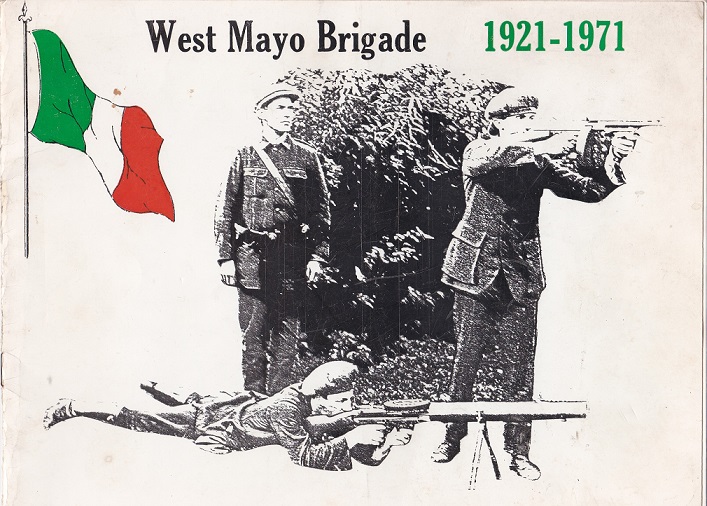
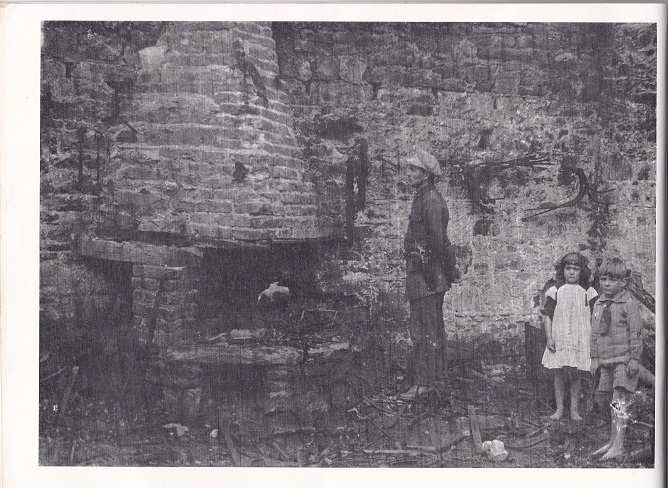
Michael Kilroy inspects the ruins of his forge after it was burned and bombed by British forces. The children in the picture are his young daughter, Mary and his son,
Paddy.
IN THE FATEFUL YEAR of 1798, when General Humbert landed a French Force at Killala, the men of Mayo flocked to his standard and had the joy and satisfaction of routing a large enemy force at Castlebar.
From there to Ballinamuck the Mayo men fought bravely and hundreds died on that tragic day after the French surrendered.
Later, many were tried and executed, among them the Catholic curate of Newport, Fr. Manus Sweeney. The spirit of '98 lived on in the hearts of the people
and, in 1867, when the Fenian rising was to take place, many young men left their homes and went away to await the call than never came. It is on record that
Sean McDermott once said that the three best Fenian centres were Newport, Kilmeena and a parish in Tipperary.
From the Fenian movement came the I.R.B. and, in the early years of the century, the Volunteers.
As in '67 so it was in 1916. In many places in Mayo young men stirred to arms all through that Easter Week waiting for the call that never came, yet, in the week
that followed one of Mayo's greatest sons joined the illustrious band of martyrs.
In the grey dawn of May 5th, 1916, a tall, erect man marched across the prison yard in Kilmainham Jail and turned to face a firing squad. The priest by his
side asked that he reconsider his refusal to be blindfolded. He smiled and said: " Father, I've looked down their rifle barrels all my life." Turning to the
firing squad he said: " Just fire when I nod my head'"
The proud head nodded, the rifles barked and Major John McBride was dead.
He had joined the illustrious names of Easter Week and his name is forever enshrined in the hearts of every Irishman, and every Mayo man is justly proud of
our great and noble Patriot.
When news of his execution reached his native county the men of West Mayo did not dispair but each man resolved that the fight would be renewed and kept
up until the cause for which John McBride had sacrificed his life was won. The Volunteers and the young Fianna lads reorganised and very early in 1917
West Mayo was one of the Country's best organised areas.
In the months immediately after 1916 the Volunteers of West Mayo prepared for the fight they knew must come-they marched, and drllled and openly defied the
British law, and when the Active Service Units were formed in the various towns they did not wait for the enemy to come to them but they openly sought to engage him at every chance, but scarcely ever did the enemy venture out from their barracks and many times the I.R.A. patrols entered the various towns to look for a fight but seldom did the opposition oblige.
In the early days of the struggle, Michael Kilroy, Brocldie Malone and Joe Ring, were walking along the road in the Carrowkennedy/Cushlough country when
they were followed by four R.I.C. men armed with four revolvers and one shotgun. The I.R.A. men were armed with two pistols and one revolver and seeing the police
approach they continued on their way. The R.I.C cycled up to them and, dismounting, fire was opened by both sides; it was a hard fight and ended with one
policeman killed and three wounded. AIl were disarmed.
Westport A.S.U. men took up ambush positions at Clogher Cross one night towards the end of April. Three lorry loads of Black and Tans were attacked and
the battle lasted for almost one hour, a number of Black and Tans were wounded. The men who took part in this action were:
Joe Ring-(Rifle), Broddie Malone-(Rifle), Tom Heavey-(Rifle), John Duffy-(Rifle), Paddy Duffy- (Rifle), Jimmy Flaherty-(Rifle), Joe Baker-(Rifle) Jack Keane-(Rifle), Martin Naughton-(Shotgun), Jack McDonagh-(Shotgun), Michael Staunton-(Rifle),
John Collins-(Rifle), L. Hogan-(Shotgun), John Bradlrey-(Rifle), Jim Duffv-(Shotgun).
Shortly after this attack, a party of three I.R.A. men staged an attack on an R.I.C. patrol in Westport as it proceeded up Altamount St. As it came towards the
Railway Bridge, it was bombed and fourteen R.I.C. men were wounded. The I.R.A. patrol, who were Broddie Malone, Joe Baker and Tom Ketterick, got safely away and spent that night at a dance in Duffy's, Cloonskill.
On 3rd May, 1921, Tom Maguire, O.C. South Mayo
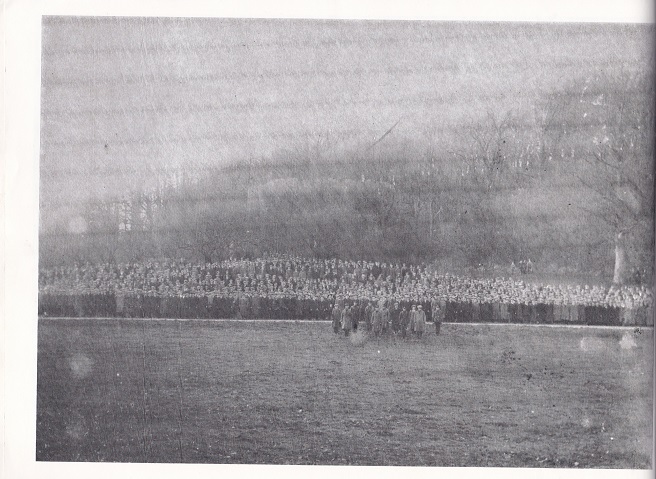
This picture was taken in Westport Demesne grounds when the Volunteers were returning from the re-internment of Vol. Jim Duffy who was accidently killed near Westport.
Brigade, was pinned down in the Tourmakeady Hills and surrounded by several hundred British troops and his entire column in danger of being wiped out.
When the West Mayo Brigade got word of his position they immediately left to his aid but arrived too late to be of assistance. Michael Kilroy left Newport with
the Newport A.S.U. but when he got to Aughagower word was received that the fight was over. The men of the Westport Unit had gone earlier to Maguires assistance and reached Derrycroff when they heard the fight was over. When the Westport men got word of Tourmakeady, they themselves were in ambush positions at Brackloon Bridge and had only left when six lorries passed through this position.
In the early days of May, 1921, the West Mayo Brigade were determined to make contact with the enemy and part of their preparation for battle was to
make their peace with God like good Irishmen and good Catholics.
Father McHugh, C.C., Aughagower, arrived at the home of Mrs. Geraghty of Bunrower, Ayle, and there the men of the Column were assembled. Fr. McHugh
said Mass, heard the men's confessions, and gave them Communion. Later, Fr. McHugh and the Geraghty family were to suffer for their kindness.
On May 6th, the combined A.S.U. of Westport, Newport and Castlebar lay in ambush on Westport Castlebar road at the Big Wall between the villages of Drimneen and Kilbree. A section of the Islandeady Company was detailed to cut the road at Cloonkeen in case any military passed from Castlebar to Westport.
In the early morning a single military lorry travelled from Castlebar towards Westport, and immediately it passed the Islandeady section started to cut the road. Sentries were then posted to watch for further lorries coming from Castlebar. The ambush party lay ahead waiting for the lorry, but before reaching them the lorry turned and, travelling at a fast pace, reached the Islandeady section cutting the road.
The sentries signalled the lorry's approach, but thinking it was coming from Castlebar, the Islandeady men took cover only to be fired on from the rear.
Volunteers Lally and O'Malley were killed, Frank O Boyle was captured and P. J. Cannon and others escaped.
The different units then returned to their own Batt. areas and, shortly after, tragedy struck when Vol. James Duffy of Prospect, Westport, was accidentally killed in the home of Austin Hastings, Rockfield. That night he was taken by his comrades
and buried in an old burial ground on a little hill overlooking Cushin village.
Each unit in its own area tried to make contact with the enemy, but in vain. The Westport unit made almost nightly visits to Westport but without any results.
On 15th May, the three units from Westport, Newport and Castlebar mobilised at Curvey, Aughagower, and on the night of 16th moved into Westport. Units went in as far as the Octagon, Lr. High St., the Fairgreen and Castlebar St., but not one
of the enemy appeared on the streets of Westport that night.
On the night of May 17, Vol. P. Marley of Glenhest was accidentally killed in the house of T. Costello, Ardygommon, Westport, and that night his comrades
buried him beside Jim Duffy on the little hill at Cushin.
Next morning, the column took up positions at the High Wall at Drimneen on the Westport/Castlebar road, but no enemy passed.
On the evening of 18th May, Michael Kilroy, O.C., directed Broddie Malone, O.C. Westport A.S.U., to take a patrol of eight men into Westport and attack any
enemy patrols in the town.
Joe Dogherty, O.C. Newport A.S.U., was detailed to go into Newport to attack any enemy patrol found there.
The men of the Westport Patrol were:
Broddie Malone, O.C. Westport Patrol (Rifle), John Duffy (Rifle), Paddy Duffy (Rifle), Tom Heavy (Rifle), John Bradley (Rifle), James Flaherty (Rifle), William Joyce (Rifle), Dan Gavin (Rifle).
The men of the Newport Patrol were:
Joe Doherty, O.C. (Rifle), Michael Gallagher (Rifle), Jim Moran (Rifle), Jim Browne (Big) (Shotgun).
Michael Kilroy took the main body of men to
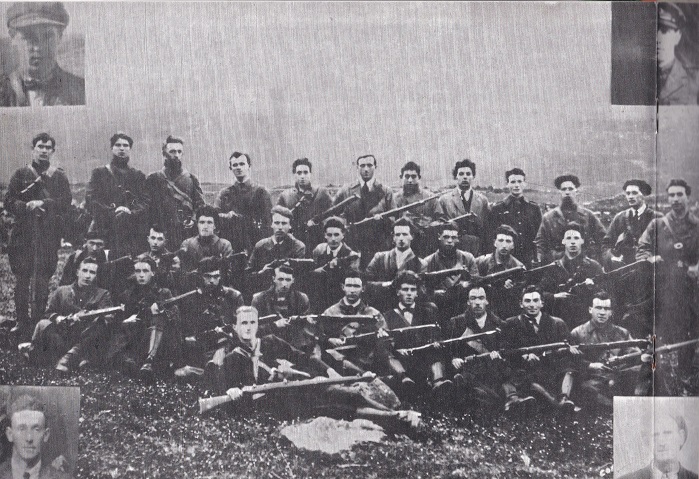
All the men that took Part in the Carrowkennedy fight are in this picture, except John Berry who was on sentry duty.
The men are (from left to right):
Back Row-Ml. Kilroy, T. Kitterick, E. Moane, J. Gibbons, J. Walsh, F. J. Cannon, P. Lambert, J. Kelly, J. Doherty, B. Malone, J. Rush, J. Ring.
Middle Row-M. Naughton, J. Hogan, J. Hearney, D. Sammon, J. Keane, J. Connelly, R. Joyce, P. McNamara, W. Malone.
Front Row-Dan Gavin, T. Heavey, J. Duffy, .tr. McDonagh, P. Kelly, J. Moran, J. Flaherty, B. Cryan, M. Staunton.
In front-Dr. J. A. Madden.
Insert (from left to right): Top- P. Duffy, J. Baker.
Bottom: M. Gallagher, T. Ainsworth.
(© Copyright reserved by J. J. Leonard & Son. Bofeenaun, Ballina)
Ballintsleva and awaited a report.
The Westport Patrol entered the town at the Convent and took up positions at the Fairgreen. They learned that a patrol of 18 R.I.C. had proceeded earlier in the
direction of Westport Station but, apparently, they learned of the presence of the I.R.A. patrol in the town and they went into the house of Dr. O'Rourke, Altamount St. The I.R.A. waited until dawn but the enemy did not return to barracks, so reluctantly they withdrew to Sandyhill, half a mile from Westport town.
The Newport Patrol made contact with the enemy and one R.I.C. man was killed.
In the early morning of May 19 Michael Kilroy moved the Flying Column to Clooneen, Kilmeena, on the Westport,/Newport road and took up ambush
positions in the hope of enemy movements in the area.
With Michael Kilroy, O.C., at Kilmeena were:
Eamon Moane, B. Vice O/C, Westport (Rifle);
Thomas Ketterick, B. Q/M., do. (Peter P. Pistol);
John Gibbons, B. Adj. do. (Revolver);
John D. Gibbons, B. Staff, do. (Shotgun);
Joe Baker do. (Rifle);
Batty Cryan do. (Shotgun);
Thomas Ainsworth do. (Rifle);
John McDonagh do. (Rifle);
Paddy Lambert do. (Shotgun);
Martin Naughton do. (Rifle);
Michael Staunton do. (Rifle);
John Collins do. (Martini Rifle);
P. Pearse do. (Shotgun);
John Cannon do. (Shotgun);
Patrick Jordan, O.C., Castlebar (Rifle); John Chambers, do. (Rifle); James McEvilly, do. (Rifle); Michael Hughes, do. (Rifle, Must.); James Hughes, do. (Rifle); William
McCarthy, do. (Rifle); Dr. J. A. Madden, do. (Rifle); P. J. Cannon, do. (Rifle, Mauser); James Swift, do. (Shotgun); Thomas O'Donnell, do. (Rifle); Thomas Maloney, do. (Shotgun); Thomas Nolan, do. (Rifle); Patrick O'Boyle, do. (Rifle);John Cooney, do. (Shotgun); Paddy Ainsworth, do. (Shotgun); Jack Connolly, Newport (Rifle); Michael Brown, do. (Shotgun); Paddy Molloy, do. (Shotgun); Pat McLoughlin, do. (Shotgun);
Larry McGovern, do. (Rifle); Paddy O'Malley (Rifle); Jim Kelly (Rifle); Jim Brown (Red) (Shotgun); Pat Staunton (Shotgun); Peter Corcoran (Shotgun); Ned
Murray (Shotgun).
The Column at Kilmeena were forty-one men,
including the O.C., and they were armed with 22 rifles 16 shotguns and three with short arms. At this time three men were engaged on communications, they were:
Joe Ring, O.C., Westport Batt. (Rifle); Jack Keane, do. (Rifle); Ned Hogan, do. (Shotgun).
The Column took up positions at Kilmeena in the early morning and the main position was behind a sod fence some fifty yards from the main road, between the now Memorial HaIl and Cummins' House.
The morning hours dragged on and at 10 a.m. a car was signalled approaching from Newport direction but the Newport men recognised it as belonging to Canon McDonald, P.P., Newport, who was attending a roundup station in Kilmeena.
A short time later, two cars were signalled coming from Newport and this time men tensed and took careful aim. The covered cars were filled with people dressed in black and slowly came into the ambush position. Fingers pressed on triggers when, suddenly, someone called: " Don't fire; they are nuns'" The two
cars which had a miraculous escape were filled with nuns from Newport and Malranny on their way to attend a nun's funeral in Westport.
Again, men relaxed and the hours passed without incident until about 3 p.m. as the men waited for a meal which was being prepared in Cummins, after which the Column would withdraw towards the Half Parish. Suddenly, there was a shout: " The Tans are coming," and immediately positions were taken as the first lorry went through the ambush position. A scattered volley met it, but it went its way.
Soon, another lorry came into view and slowed at the approach to the Parochial House. It stopped there just behind Canon McDonald's car. It was several
hundred yards from the ambush position. The Column new changed positions and opened fire on the party at the priest's house. The fire was returned and a
machine-gun mounted on the bridge blasted the Column position. The exchange of fire continued for some minutes until the occupants of the first lorry which had
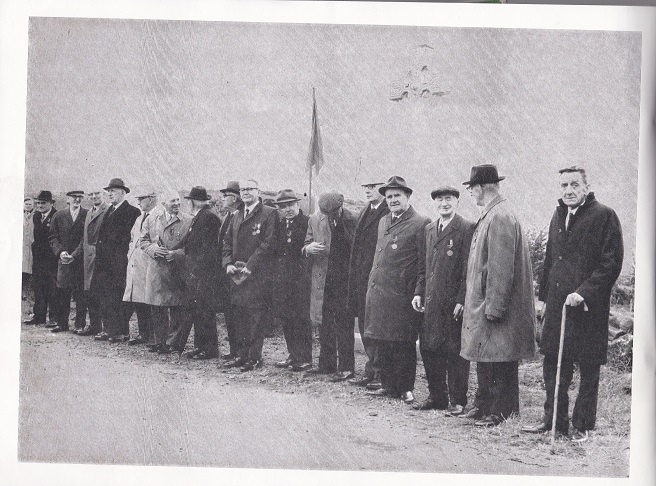
Survivors of West Mayo Brigade A.S.U. pictured at unveiling of Memorial at Kilmeena, 23rd May, '71. From left-Paddy Duffy, Michael Hughes, Tom McEvilly, Eamon Moane, Paddy O'Malley, Broddie Malone, Batty Cryan, Dan Sammon,
Tornmie Heavey, Michael Brown, Larry McGovern, Joe Baker, Tom Ainsworth, Jack Connolly, Paddy Lambert.
Photo Courtesy McLoughlin's Studios.
gone towards Newport pulled up just beyond the railway bridge and came back on foot. Unobserved, they took up positions and mounted a machine gun on Knocknabola road which opened up on the now exposed column positions. In the first few seconds, James McEvilly, Tom O'DonneII, John Collins, Pat Staunton and
Paddy Jordan were mortally wounded. Paddy'O'Malley, Paddy Molloy, James Swift, John Chambers, John Cannon and Michael Hughes were seriously wounded.
Despite those losses, the men bravely stood their ground and for a time panic reigned among the enemy at the Parochial House, Inspector Donnellan forced in
the door where the priests sheltered and accused them of firing on his men.
Fr. T. Killeen, C.C., Malranny, now P.P., Newport and Fr. M. Walsh, C.C., Kilmeena, left the priest's house while the battle still raged and went on to the hill at Clooneen and anointed the dying and wounded. Just as Fr. Killeen anointed T. O'Donnell, J. Collins, and Pat Staunton, all three died.
The O.C. now gave the order to retreat and this the men had to do across the top of Clooneen HiII, hit by rlfle and machine gun fire from both sides. A brilliant rearguard action was fought, with every yard of ground contested, until after some hours the column reached the safety of Aughagowla, carrying the wounded with them; but John Cannon, P. O'Malley and P. Molloy were taken prisoner.
At Aughagowla, the wounded were dressed by Dr. Madden and Nurse Joyce, Clogher, and that night the entire Column, again with the wounded, marched to
Skirdagh, via Derryloughan, crossing the Newport river at the Weir Bridge. That night the broken but undefeated Column rested in the friendly houses at Skirdagh and during the next few days they nursed their wounded and thought sad thoughts of their dead comrades.
The first signs of dawn had not yet touched the eastern skies on the morning of 23rd May as the men slept and the sentries watched. At 3 a.m. the sentry
noticed enemy movement on the road and opened fire. A large enemy force had come down the old bog road and were now almost into Skirdagh Village.
The shot from the sentry roused the others and immediately, the battle of Skirdagh started. The first thoughts were for the wounded and they were moved
back into the hills for safety. E. Moane, J. D. Gibbons, Jim Moran, B. Cryan and P. Mcloughlin took the three wounded men (J. Chambers, Michael Hughes and J.
Swift) on their backs through Glenlaura to Letterkeen in the Shramore area. When they reached Letterkeen they had to move further into the Ballycroy mountains
as the military had already reached Letterkeen with a view to surrounding the Column. That same night the wounded men were again moved, on horseback, this
time, to Laherdane, with William Chambers of Shramore as a guide.
Back in Skirdagh, Michael Kilroy and his men were pinned down in the hills but they stubbornly resisted every effort of the enemy to close on them. Reinforcements of military came from as far away as Galway and Sligo, and by evening the fighting men of West Mayo were completely surrounded. The fight had lasted from 3 a.m. 'till well past noon, while the enemy awaited more assistance and they could crush the Column at once. But as night fell, Michael Kilroy and his men
infiltrated through enemy lines and crossing the Skirdagh river got safely into Glenisland. Early in the fight Volunteer Jim Brown of Kilmeena was fatally
wounded. His close friend and neighbour, Pat Staunton, was killed in Kilmeena.
On the 24th May, the Column rested in Glenisland and watched the enemy troops search the Skirdagh, Buckagh, Shrarnore and Nephin mountains. From
Glenisland they moved to Letter in Islandeady and on the morning of 26th they reached Aughagower, where they were joined by the men of the Westport Unit
that had parted from them the day before the Kilmeena action.
While the rest of the column fought at Kilmeena and Skirdagh, Broddie Malone and the men of his patrol were resting near Westport on the 19th when
they got word of the Kilmeena engagement and immediately set out for the scene of the fighting but had only reached Carnaclay when they got word that the battle was over. That evening Joe Ring, J. Keane and N. Hogan joined with Broddie Malone and his men,
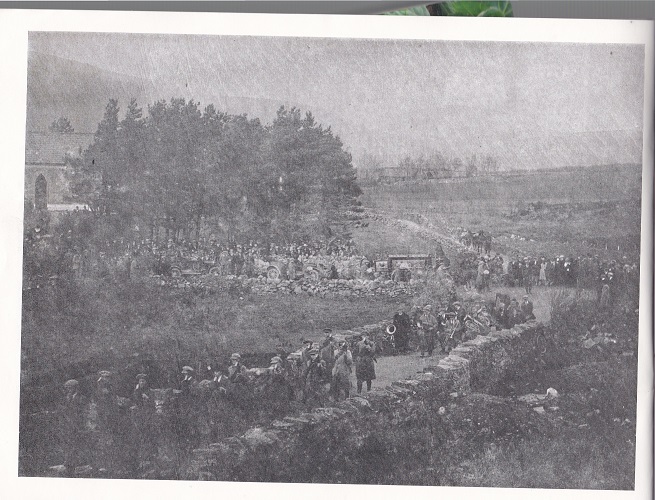
This picture was taken at the funeral of VoI. P. Marley, Glenhest, who was accidently killed on 17th May, '21, in the house of T. Costello, Ardygommon, Westport.
The firing Party from the front pair. left to right (all are from Tiernaur Coy.) are: Larry McGovern, John Gibbons (R.I.P.); Pat McLoughlin (R.I.P.), Michael Brown, Willie Carolan (R.I.P.), Brodie McNulty (R.I.P.), Paddy McGuire (R.I.P), John P. O'Boyle (R.I.P.), Padraic Joyce (R.I.P.), Patrick Lavelle (R.I.P.), Willie McNulty (R.I.P.), Johnny Burke (R.I.P.). Officer in charge was Jimmy Flaherty (R.I.P.), Westport. John
Fergus (R.I.P.). Newport accompanied the group.
and Joe Walsh, John Berry and Willie Malone also joined the Westport men. The three latter had just returned from England.
On the evening of 23rd, the Westport unit heard news of the Skirdagh fight, and knowing that if any prisoners were taken they would be moved from Westport by train. They decided to hold up the morning train from Westport, but no prisoners were aboard.
Michael Kilroy, having again joined with the Westport men, now had 33 men in his Column and they rested at Curvey and Lanmore before moving to Owenwee, where they spent the night of 29th May. On June 1st they burned Drummin R.I.C. Barracks.
On a day that will long be remembered, June 2nd, the men of the West Mayo Brigade rested in Claddy. That morning four men from the Louisburgh Batt. joined the Column. They were: P. J. Kelly, Dan Sammon, J. Harney and P. McNamara.
In the early afternoon of that day the sentries reported three enemy lorries held up at Carrowkennedy by a trench cut in the road. Having made local men
fill the trench with turf the enemy crossed and proceeded towards Leenane.
The O.C. immediately moved the Column towards Carrowkennedy, determined to ambush the enemy on his return from Leenane. Before an ambush site could be selected the enemy lorries were seen returning a few hundred yards away. The men of the Column did not hesitate-they rushed to the fences and took up
positions. As the leading lorry came opposite the position fire was opened and the lorry stopped, its driver dead. The time was 3 a.m. and during that long June day the fight raged. The enemy brought a Lewis machinegun into action but it was quickly silenced and the gunners dead. Some of the enemy occupied a house by the roadside and continued the fight from there. The sun was setting behind Croagh Patrick before the fight was over and the enemy completely defeated , with 12 dead, and 13 surrendered. As night fell, the lorries were burned and the victorious Column
returned to Claddy, carrying the arms they had captured-25 rifles, 25 revolvers, one Lewis machine gun, 60 Mills grenades and 5,000 rounds of .303 ammunition.
After a hearty meal at Claddy the men left for Drummin, and early on the morning of 3rd June reached Maumcasser and remained in the Louisburgh area until 9th June, when they marched to Shraheen in Aughagower. From there they moved to Derryloughlin in the Newport area and the 13th June found them in Derrymartin, at the foot of the Nephin mountain, and here the now famous photograph of the Column was taken.
The Column now marched to Barna Gaotha and from there went into Crimlin and were billeted in the villages of Laragon and Gort. Here for the first time since Carrowkennedy the enemy made his presence felt. A strong force of military surrounded the villages but were spotted by sentries in time and all the men
got safely out and took up positions on a hill overlooking Laragon. Having searched all the houses, the enemy left and the O.C. moved his men into Parke and from there to Carracastle near Bohola. Here, the military again raided houses after the
Column had left but no clash occurred. From Bohola the men marched to Prizon near Balla and then back into the Belcarra/Ballyheane country. Reports now
came in about large forces of military closing in behind and the men moved back into Killawalla and then to Aughagower.
From intelligence reports it was now evident that the enemy knew that the Column was in the area and a large encircling movement was being put into
operation. By the time the Column had reached Owenwee it was surrounded by 4,000 troops. The O.C. called the men together and explained the position and,
in the early morning of July 4, the Column split up into twos and threes and made their way through the enemy cordon, not one man being captured, all getting safely
away. In the following days the truce came, and the war was over !
On Sunday, 23rd May, l971, memorials were erected at Kilmeena and Skirdagh to honour the men of the West Mayo Brigade A.S.U. who fought there. The memorials were unveiled by Mr. Frank Aiken, a former Chief of Staff, I.R.A.
On Sunday, 6th June, l97l, General Tom Barry unveiled a memorial at Carrowkennedy to honour the men West Mayo of Brigade A.S.U. who fought there.
The Committee who organised the erection of the memorials were:
Chairman, Willie OMalIey; Vice-Chairman, Larry McGovern; Secretary, Willie Sammon; Joint Treasurers, John Quinn, Dominick Mulchrone, John KeIIy.
Committee: Pat Feehan, Anthony Keane, Tommie Dogherty, Michael Kilcoyne, Pat J. O'Malley, Brian Corrigan, Birdie Ryder, Bill Burke, Andrew Moran, Pat Quinn.
A Committee was formed in Chicago and they collected a very large sum of money which helped very much towards the cost of the memorials and especially towards the most of memorial windows in Newport Church to the memory of General Michael Kilroy. They will be unveiled on Sunday 18th July, 1971.
CHICAGO COMMITTEE
Eamon O'Malley, Chairman; Dan O'Donnell, vice-chairman; Johnnie MacHale, Treasurer; Mike Heraty, Secretary.
Committee:
Joe Dyra, John Mulchrone, Pete Mulchrone, Ambrose Kelly, Ed. Spellman, Mike O'Donnell, John O'Donnell,
Frank Chambers, John Mulkerins, Mike Gibbons, Paddy Gibbons, Frank Grady, Pat O'Malley, Joe Sweeney, Dick
Lyons. Seamus Grady, Mike Mulchrone, John Joe Spellman, Jack Kilroy, Pat Kilroy, Joe Kilroy, Jim Kilroy,
Paddy Kilroy, Dick O'Donnell, Mike O'Donnell.
Ladies' Committee:
Mrs. Ambrose Kelly, Mrs. Mike Heraty, Mrs. John Joe Spellman, Mrs. Pete Mulchrone, Teresa McNulty, Mrs.
Michael O'Donnell, Mrs. Joe Dyra, Mrs. John Mulchrone, Mrs. Patrick O'Malley.
Newport Historical Society.






